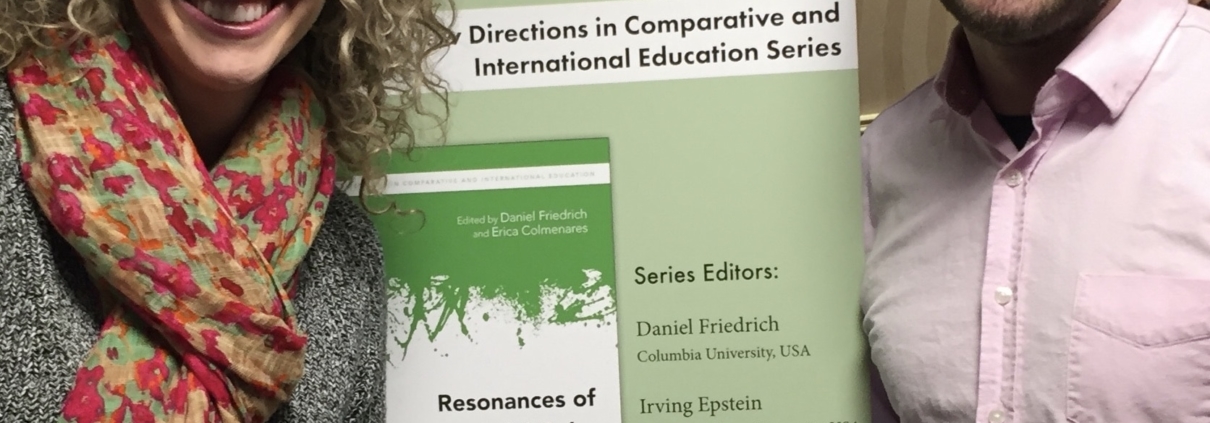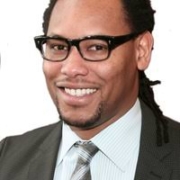Today we talk about a television show that was hugely popular in Latin America called El Chavo del Ocho.
The show crossed borders across Latin America, taking on a multiplicity of meaning. My guests today, Daniel Friedrich and Erica Colmenares, have a new edited collection that explores how the show worked and produced particular visions of Latin American childhood, schooling, and societies. They also contend that their approach to studying El Chavo del Ocho is a new direction in comparative education research.
Daniel Friedrich is an Associate Professor of Curriculum at Teachers College, Columbia University where Erica Colmenares is a doctoral candidate in the Curriculum and Teaching department. Their new edited collection is entitled Resonances of El Chavo del Ocho in Latin American Childhood, schooling and societies. It is the first book in the new Bloomsbury series “New Directions in Comparative and International Education.”
Citation: Friedrich, Daniel & Colmenares, Erica, interview with Will Brehm, FreshEd, 98, podcast audio, December 4, 2017. https://www.freshedpodcast.com/friedrichcolmenares/
Transcript, translation, resources:
Will Brehm 2:25
Danny Friedrich and Erica Colmenares. Welcome to FreshEd.
Daniel Friedrich 2:28
Thanks, Will. Thanks for having us. I’m really excited to talk to you.
Erica Colmenares 2:31
Thank you so much, Will. We’re really happy to be here.
Will Brehm 2:34
So, both of you grew up watching this TV show that I actually never heard of. It’s called El Chavo del Ocho. Can you introduce this television show, this Spanish speaking television show, to the listeners?
Erica Colmenares 2:47
Sure. El Chavo del Ocho was a Mexican TV show. It was created by Mexican author, comedian, director, producer, actor Roberto Gómez Bolaños, who was also frequently known as “Chespirito”, which is a play on the Spanish pronunciation of Shakespeare. And the show actually consists of a small group of adult actors – many of them acting as children – who live in a Mexican vecindad, which is a lower-class housing complex. And the show centers around the main character and namesake, El Chavo, who himself is an orphan boy, and he spends a lot of time in the inner central courtyard of the vecindad with his fellow neighbors and friends. And it’s a really humorous show, and it relies a lot on a mix of physical humor, double entendres, misinterpretation, among numerous other comedic tropes. And there’s a simplicity to this show that appeals to the youngest of audiences, but can engage older viewers through nostalgia and tenderness, for example.
Will Brehm 3:52
When was the show on television?
Erica Colmenares 3:55
That’s a good question. Originally, El Chavo actually first appeared in 1971 as a sketch on a Mexican show called Chespirito. And it hit its peak of popularity in the mid-1970s, and officially ending in 1980. But the show was actually so popular that they had to create an additional set of syndicated episodes that lasted all the way until 1992. So, all in all, you could say that the show had about a 20-year run.
Will Brehm 4:27
Wow, that’s incredible. And where was this show produced? What country? And then how many countries did it reach in the Spanish speaking world?
Erica Colmenares 4:38
Yes. The show had a tremendous reach. It was actually originally produced in Mexico. But its reach included all of Latin America, plus Brazil, Spain and the United States. And it actually had an approximate audience of around 350 million people per episode across the Americas. And one of the things that we’re actually grateful for in this book project is that many of the scholars who joined us and wrote chapters for the book actually came from the numerous locations where El Chavo was watched. So, for example, Nicolas and Danny from Argentina, where the show aired, Carlos from Colombia, myself from Venezuela, Ana Paula and Rita from Brazil, Vicky from Chile. Limarys was from Cuba, Puerto Rico and the United States, Dulce, José, and Ernesto who come from Mexico.
Will Brehm 5:32
Wait, so 350 million people watched each episode as it aired?
Erica Colmenares 5:37
Correct. According to the statistics that we came across.
Will Brehm 5:41
That’s unbelievable. Given that, say in the United States of America, a popular TV show might have maybe 20 million people watching it.
Daniel Friedrich 5:51
Right, but here you’re thinking about a show that reaches every single country. And here’s an experiment for the audience, right? I challenge the audience to find any Latin American person ages five to 50. Mention El Chavo del Ocho and see what the reaction is. I don’t think there’s any person that’s not going to have a reaction. The reaction is not going to be all the same, but every single person is going to have a reaction to this show.
Will Brehm 6:17
Right. So, it’s a very common household name for many Spanish speaking people around the world.
Erica Colmenares 6:24
Absolutely.
Will Brehm 6:25
So, what does the name actually mean? I don’t speak Spanish. So, El Chavo del Ocho, what does that actually mean?
Erica Colmenares 6:32
So, El Chavo is not actually a name, but Chavo is a term for lad. And we never actually find out what the character’s real name is. And on the few occasions where the character is actually about to say it, he’s usually always interrupted in some way. And so, the characters of the show and the audience is always left with this kind of lingering mystery. And as for the number, the number eight of his name, his name is El Chavo del Ocho. The show was originally broadcast in Mexico on Channel Eight, hence the name El Chavo, the lad of Channel Eight, del Ocho. But when the show actually moved to a new network, Televisa, and it was no longer on Channel Eight, the show had to come up with a new reason for this seemingly random “eight” attached the title. So, in the syndicated episodes, El Chavo insists every now and again that he lives in apartment eight, although we never actually see him there, or we never even see the apartment. So, there’s a lot of mystery.
Daniel Friedrich 7:34
When we see El Chavo coming out of somewhere, it is usually out of the wine barrel where everyone supposes that he’s living. He usually wakes up from naps coming out of a wine barrel, so even though he argues that he’s from apartment eight, that is never proven in the show.
Will Brehm 7:51
So, both of you watched this growing up. Do you have any favorite sketches that stick in your memory, even as adults today?
Erica Colmenares 8:00
That’s a really hard question because there’s just so many of them that I have. In fact, as I rewatched many of the episodes in preparation for the book, I noticed I rewatched a lot of my favorite episodes. But I noticed that as an adult, a lot of my favorite episodes were very different from my favorite ones as a child. For example, growing up any sketch that involved one of the characters whose name is La Chilindrina was really it was my favorite, because I loved her kind of sneaky, bossy, humorous ways. But now that I’m older, I’m really definitely more in love with the character of Don Ramón, so any of the sketches involving Don Ramón are really my favorite.
Daniel Friedrich 8:42
Yes, for me, it’s interesting because memory is a funny thing, and like Erica says, the resonance of the show has within our childhoods, and when we watch them as adults as part of a research project, but also I watch them with my kid, they change what they mean to me, and how I react to them change. But there’s one episode that for me is very special. And I spent quite a bit of time on this in the chapter that I co-wrote with my friend Nicholas. So, most of the episodes take place in the vecindad, right, in his neighborhood. But there are about 28 sketches that take place in school. And there’s one episode in which the teacher has to leave. And he leaves this very specific character in charge of the classroom, that is Don Ramón. Don Ramón is in the show the poorest character, the one that everyone’s always making fun of because he’s always hungry, because he’s always looking for a job; he can never hold a job. He always displays his ignorance on what everyone else knows. So, in many ways, he’s always the butt of a joke, but because of an emergency, the teacher has to leave. And Don Ramón, as he takes over the class, he starts to teach children things that are never taught in school, like the symbol for a poisonous bottle, or what happens if you put your fingers in an electrical outlet, so things that for him are common sense, but that he and no one else learned in school. So, when the teacher comes back expecting total chaos, here is the kids completely engaged in this very unusual class, and it is very unusual pedagogy. So, I found that episode fascinating. I loved it as a kid. I still love it now. And I think it shows so much potential for what they showed us for some of the problems in the show. So, I still think that that is my favorite episode.
Will Brehm 10:34
So, what does the show do? In a sense, it sounds like there is an educational component in it. In your book, in your edited collection, you talk about it, in a sense, as a curriculum. So, what does that actually mean? How is this TV show educational, part of a curriculum?
Erica Colmenares 10:55
Well, I think it’s important to parse out the two. I actually don’t think that the show is necessarily educational. I do think you could argue that it is curricular in the sense that the show produces visions of childhood and students and schooling and a sense of “Latin Americanness”, if there is such a thing. And of course, it produced history, but personally, I don’t think it is necessarily educational.
Daniel Friedrich 11:20
Yes, I think it’s important to distinguish this show from other shows such as Sesame Street, which have an intentional pedagogical task, where they’re trying to teach something very specific. In the case of this show, it’s harder to know what the lessons are. And in this way, that’s what we thought is very appealing of the show, is how Latin American it is – how different it is from usual American shows based on schooling, or on teenagers, or on kids, where they always have to come with a lesson, with something that this how we should live our lives. I think El Chavo complicates that in some ways, even though in some episodes they tried to make morality clear. The shows on citizen, the shows on showcasing of certain ways of living that tend not to be showcased in American shows, make it hard to be called educational. But like Erica said, I agree that it is curriculum. In the same way that much of pop culture is curriculum; in the way it produces the relations of knowledge, it produces visions of the good life, it produces visions of childhood, and many others.
Will Brehm 12:37
So, what are some of those visions of the good life or the visions of childhood that El Chavo shows or represents or depicts?
Erica Colmenares 12:47
I think that depends on who you ask. And that’s one of, I think, the strengths of the book: is that depending on the author, some will give very strong critiques of what it depicts, for example, in regards to childhood. We have a couple of authors, especially the ones from Mexico, that say that the show actually, for example, romanticizes poverty, or valorizes this notion of neoliberal mentality of individual will where , “Oh, if you just try hard enough, you can make it in life”, or, “If everyone would just get along, then we’ll be able to achieve happiness or well-being”. So, there’s a lot of difference in opinion, I think, in regards to them. And that’s one of the things that I feel this collection of chapters helps to highlight.
Daniel Friedrich 13:39
Yes, and the collection does not aim to understand the deeper meaning of El Chavo. We’re not trying to arrive at a consensus of what El Chavo means or what it does. I think we invited a very diverse range of scholars from all over Latin America in order to understand different visions. So, the chapter that I wrote, we think, for example, of what it means to situate a show about schooling in a school in which there is no progress, right. So if you think of other popular culture shows on schooling, they tend to follow the school calendar, especially when they’re live action, right, because they have to follow the growth of the actors, the seasons tends to start with the beginning of the school year and they tend to end after testing and kids go on vacation, because kids have to grow. And they go from grade to grade, they reference previous learning. In this show, because the premise is these are adults dressed as children, they don’t have to account for growth. So, in the classroom, you see them always making the same mistakes, never learning, never moving. The show is still in the last two decades, and they all have the same teacher, they’re always in the same grade. In that sense, is more similar maybe to animated shows, such as the Simpsons or South Park. But I think there’s something interesting to think about, What does it mean to think of a schooling in which they discuss grades, they discussed passing or failing an exam, but that has no consequences because in the next episode, they go back to scratch. What does it tell us about Latin American schooling? In which ways does it serve as a metaphor or serve as a tool for us to think about what does it mean to think about schooling in particular context? So that’s one of the productions of that particular vision of schooling in Latin America that I think this show helps us think through.
Will Brehm 15:30
So, walk me through that. What do you actually learn about, say, Latin American schooling, by thinking through that metaphor presented in this TV show?
Daniel Friedrich 15:40
Well, I think that in schooling scenes in the US, those tend to reinforce the meritocratic ideal of: if you work hard enough, you can overcome anything, right? If you’re smart, and you have a work ethic, you can go forward in life. This show’s lessons are not so clear. I think, like the context in many American cities in which this show was shown, people are not such strong believers of meritocracy. They’re not convinced that if you work hard and you’re talented, through schooling you’re going to go far in life. And you look at El Chavo, who is a very poor boy from Mexico. And no matter how hard he tries, he’s stuck, right? In some ways. While in other ways, he’s loved, he loves, he loves to learn, he loves to have fun. He seems to be having a good time. But the idea that, what is it that we’re here for? That is a question that’s always being asked. And I think that’s a question that in many places in America, people still ask. Why are we in school? It’s not a given that if you go to school, you’re going to have a better life.
Will Brehm 16:56
It’s interesting that on the one hand, there is this regional component thinking about what you said earlier: What is Latin American? What is Latin Americanness in schooling? and trying to read and understand those more abstract ideas through this TV show. But at the same time, this TV show was being broadcast in national context, and it was traveling across nations in Latin America. Is there any insight that you’ve got from putting this book together that shows some of these different meanings, how they emerged in these different national contexts and how some of these meanings might have actually differed within this region of Latin America?
Daniel Friedrich 17:43
One of the things that I found really interesting in the process of doing this work was to find out that the place where El Chavo was most resisted, is at home, is in Mexico. Partly because El Chavo and the director/actor that created him, Chespirito – Chespirito was so tied to Televisa, who is this multimedia corporation, who had strong ties to the ruling party in Mexico, to the PRI, that ruled Mexico for over 70 years, that I think people – and especially critical scholars – are very aware of the ways in which this show and its popularity was used to cover up other things that were going on; how Televisa mobilized the show to create a populist entertainment that was not providing the space to have other kinds of conversations that were political in nature and needed to happen. Now, when that show travels, that context does not travel with it, right. So Televisa doesn’t mean anything in Venezuela, or in Argentina, or in Chile, or in Puerto Rico in the ’70s or ’80s. So, the way which the show is received is different, it’s structured differently. Even though the language is the same – except in Brazil, where it’s dubbed into Portuguese – the meanings of the show change as it’s local in different places. There was one chapter that I started that we were unable to publish because the author, because of the crisis in the country, could not finish it. In Chile, where he was writing about the ways in which, when the actors traveled to Chile, Pinochet’s dictatorship organized a whole parade around them. And the way in which the parade could be read, both as celebrating a particular kind of childhood internationalism and also Latin Americanness. But at the same time, it had some of the more complicated and nuanced complexes happening in the middle of a brutal dictatorship.
Will Brehm 19:53
So, in Mexico, I understand the connection between the television corporation and the ruling party, the PRI, and this TV show, you said that sometimes it covered up things that were going on. Do you have an example of that? Like, what sort of things was the TV show covering up?
Daniel Friedrich 20:14
So the chapter, especially by Ernesto Treviño Ronzón, he speaks very clearly about the way in which this show was used in particular schedules, and was used to sort of given narrative of, “if we all get along, then all the inequalities, all the injustices, all the sad aspects of our lives, can be overcome, because the main goal here is that we are all one. We’re all friends, we all want to get along.” So that message of a harmonious society, of solving deep economic issues, by just getting along, is a message that was deployed at specific times, very skillfully by Televisa. And by the ways in which Chespirito allied himself with specific political actors in order to become more and more popular.
Will Brehm 21:19
Do children still watch the show today?
Erica Colmenares 21:22
So, yes. Children do actually still watch it, but the show – it’s important to remember that the show itself is no longer running. So, it’s not like it used to be when Danny and I, for example, were growing up, when it was usually during prime time in many countries. But you can still see the show through reruns, or there’s a popular cartoon spin-off, you can see it on cable or internet. We don’t have the exact numbers or figures, but from personal anecdotes, and in my own experiences in Venezuela, for example, I do think children today are still very familiar with the show. But I don’t necessarily think it’s not the same experience as we had when we were growing up.
Daniel Friedrich 22:07
I know it’s still playing in Chicago, for example. I know in Chicago in some of the Latino channels, it’s still playing. I also just want to mention that when I was contemplating the idea of editing this book, one of the things that pushed me to it is, as I was walking into my building, I saw the doorman of my apartment building, who is from Puerto Rico, watching El Chavo on his cell phone and laughing hysterically. And that pointed to me, there’s something here that we need to talk about.
Will Brehm 22:41
So, people that are watching it today, do you think the show translates into the contemporary moment, or does it feel dated?
Erica Colmenares 22:51
I think it depends on which show. If you’re doing the cartoon spin-off, I do not think it doesn’t feel dated. But I would think that if they’re watching the original show, I do think there is kind of a notion or an idea that, “oh, this comes from the past, from a different time”, just because of the costuming, the staging, some of the phrases that they use; it could give that impression that it’s not from the current times, obviously. But I think some of the messages in the show can still very much apply or resonate with children that watch it today, especially the comedy.
Daniel Friedrich 23:29
I also think that the writers were very skillful in avoiding any specific references to context. So, there are a very few mentions of the World Cup here and there, ’86, for example. But they do not talk about local issues, they do not talk about what’s happening in Mexico, the time. They don’t mention any names of politicians. So, in a way, that is what allowed it to travel. That’s what allowed it for any different set of audiences to appropriate to show and to make of it what they wanted to make out of it.
Will Brehm 24:04
So, this edited collection that you put together is the first in a new series called New Directions in Comparative and International Education put out by Bloomsbury. And I just want to ask you: This sort of work that you’ve been doing, this edited collection, how is it a new direction of comparative and international education?
Daniel Friedrich 24:25
I think that’s a really good question. So the series that I employed it in with Irv Epstein and Steve Carney, we are trying to look for underexplored areas in the field of comparative international education, especially theoretically, and I think the volume that Erica and I co-edited, we were looking for people doing different kind of work. So, one of the things we wanted to do is translate into English, Latin American scholars, and give them a space to speak to an audience where they’re usually not heard. But not only because they’re Latin American, because they also bring with them theoretical frameworks and approaches that are not the most popular or the most used in the field of comparative international education. For instance, Erica herself, her chapter that I think is brilliant, brings in affect theory. So how much have we explored of affect theory and affective turn within comparative international education? I think not much. And I think the serious strength to that is trying to bring different theoretical, epistemological perspectives to the field to get out of a somewhat stuck position within the usual frameworks that it tends to use.
Erica Colmenares 25:42
And I think there also tends to be in, in any work of analysis, trying to figure out, as Danny already mentioned, what something means. And what we wanted to really avoid is doing that same thing, is trying to figure out, “So what might El Chavo mean to somebody from this part of Latin America versus another part of Latin America?” And we used a lot of concepts from Deleuze and Guattari. And one of the things that we try to do is we really wanted to figure out how is it that the show is working? And I think that’s a different question. When you ask how something works versus what something means, that invites different methodologies, different epistemologies and ontologies. So that’s really, I think, the spirit of the new series that’s coming out with Bloomsbury.
Will Brehm 26:31
So, are you saying in a sense that a lot of research in comparative education looks at, “What is the meaning of something?” and not, “How something works?”
Erica Colmenares 26:42
It could, especially in cultural studies, which one could say that this is an example of a cultural product, and when you study a cultural product, we tend to look at what it means, or what it might mean. And so, one of the things we wanted to do is move away from that.
Daniel Friedrich 27:01
Yes, and also move away from the idea of comparison in a traditional sense in which, OK, we have a stable object and we look at it from this perspective compared to this other perspective, or this location compared with other location. El Chavo, because of the way in which it traveled, it illustrates the mobility of both ways of seeing, ways of sensing, but also the very repressive re-appropriation of this, that is not that anymore, right. So, as it moves, it’s not the same thing anymore. And in a sense, it’s impossible to capture what El Chavo is. It’s not one thing, but it also, as it travels, different people and different generations rediscover it. And as I was saying before, right at the beginning of this interview, it’s not the same Chavo as I was watching when as a kid, the one that I’m watching now with my kid. It’s not only that I changed, but the ways of looking changed. So, the thing itself changed. I think that’s something that is a different approach to a more traditional perspective that tries to seek an objective understanding of a stable object out there.
Will Brehm 28:19
It’s really refreshing to see this in the field of comparative and international education. I also always … the theories of Deleuze, for instance, I think those were translated into English in the 1990s, so almost 30 years ago, and it’s like, comparative education is just now really taking them on. I always find that. Why is comparative education so slow to the bleeding edge of theory?
Daniel Friedrich 28:49
I think it’s not a question that’s easy to answer. I think part of it is sort of the more pragmatist wing within comparative ed that is trying to assess programs and to implement programs to solve concrete issues in the field. And many people see that as completely unrelated to how we see those issues. So how we understand an issue, how to answer the fact that it becomes an issue. I think that these different theoretical understandings and lenses and kinds of questions lead us to a different field. So, I think that people might read this book and might not even identify it as part of the comparative and international education field. And I think that’s where Deleuze and Guattari’s words come to light for us, which is: We’re trying to invent something new. We’re trying to invent a new concept. We’re trying to invent a new vocabulary to describe things and to discuss things that for us are relevant.
Erica Colmenares 29:52
And also experiment. Not only invent, but most importantly, experiment with what could be. ‘What are the possibilities that could be out there?’ is really important as well.
Will Brehm 30:03
Well, Danny Friedrich and Erica Colmenares, thank you so much for joining FreshEd. It really was a pleasure to talk today.
Erica Colmenares 30:08
Thanks for having us.
Daniel Friedrich 30:09
Thanks. Will.
El Chavo del Ocho as a New Direction in Comparative Education










